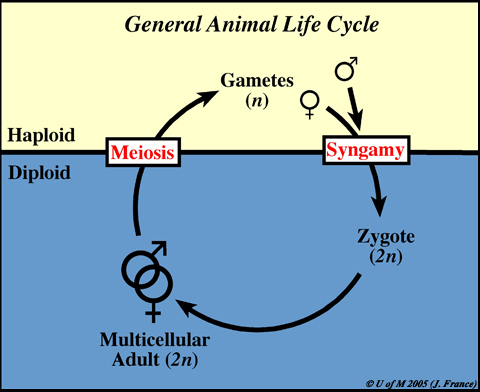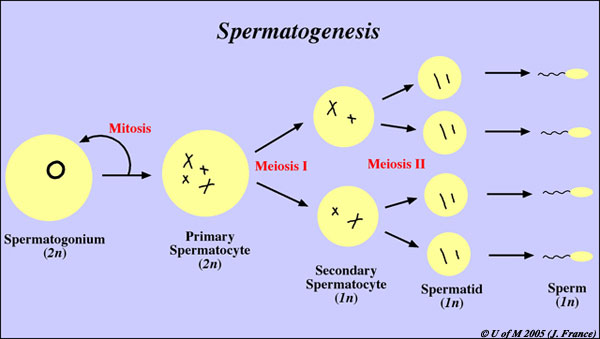
 |
Animal Life Cycle
The purpose of this laboratory session will be to examine some basic aspects of animal development and reproduction. A typical life cycle pattern for a multicellular animal is illustrated below:

Diploid (2N) adults give rise to gametes (sperm and ova) through the special type of cell division, meiosis which reduces the chromosome number to the haploid (n) number. At fertilization, the fusion of sperm and ovum generates a diploid zygote which through mitosis, differentiation and specialization leads to a new multicellular animal. Variations on this theme occur, especially among simpler animals which may include along with the above pattern asexual methods of reproduction in which new individuals are produced by a process in which the basic type of division is mitosis.
Gametogenesis is the process of sperm or ovum production and as stated above involves cell division by meiosis. We will examine gametogenesis as it occurs in mammals.
Spermatogenesis
Canadian Campbell 2nd ed. Fig 46.12)
In the mature male functional sperm cells are produced within the seminiferous tubules of the testes. Around the periphery of the seminiferous tubules are located specialized cells known as spermatogonia. Spermatogonia are diploid cells set aside early in embryonic development. They may divide by mitosis to generate more spermatogonia or by meiosis to produce spermatids, each of which will differentiate into a mature sperm cell. Spermatogonia destined to undergo meiosis first differentiate into primary spermatocytes which undergo the two divisions of meiosis. After the first division the cells are referred to as secondary spermatocytes which in turn undergo the second division to become spermatids.

Examine the prepared cross section of mammalian testis and compare with the above image
Examine the seminiferous tubule using the 40x objective
Oogenesis
Canadian Campbell Fig 46.12
Oogenesis is the process when haploid ova are formed and it occurs within the ovary. In the typical mammalian situation a diploid primary oocyte divides by meiosis producing, after the first division, a secondary oocyte and a polar body. In the second division the secondary oocyte divides giving rise to an ootid and another polar body. This second division does not occur unless fertilization of the secondary oocyte by a sperm occurs.

Examine a mature follicle and locate the mature ovum within the follicle. Due to the plane of section, it is unlikely that you will be able to locate polar bodies. A mature follicle is a fluid filled spherical structure with the ovum located in a projection of cells into the center of the follicle.
![]()
